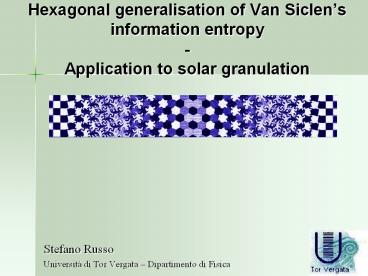Hexagonal generalisation of Van Siclen - PowerPoint PPT Presentation
Title:
Hexagonal generalisation of Van Siclen
Description:
Set of images obtained trough a fast frame selection system, at the SVST (La ... In order to utilise the isotropy properties of the hexagonal lattice, we have to: ... – PowerPoint PPT presentation
Number of Views:140
Avg rating:3.0/5.0
Title: Hexagonal generalisation of Van Siclen
1
Hexagonal generalisation of Van Siclens
information entropy-Application to solar
granulation
- Stefano Russo
- Università di Tor Vergata Dipartimento di Fisica
2
Granulation
Set of images obtained trough a fast frame
selection system, at the SVST (La Palma) on the
5-6-1993. Technical data wave lenght 468 5 nm
exposure time 0.014s. The time series covers 35
min. the field of view is 10 ? 10 Mm2.
3
Convection
Parameters to describe the convective regime
? thermal expansion coefficient d3 convective
cell volume ? cinematic dissipation coeff. k
thermal diffusivity coeff.
- Lab experiments showed a new convective regime
at high Rayleigh numbers (Rgt107).
4
A new paradigm
Granule as classic convective cell
- Old paradigm (mixing-length model)
- fully developed turbulence with a hierarchy of
eddies - quasi-local, diffusion-like transport
- flows driven by local entropy gradient
- New paradigm (lab numerical experiments)
- turbulent downdrafts, laminar isentropic upflows
- flows driven by surface entropy sink (radiative
cooling) - larger scales (meso/super granulation) driven by
compressing and merging - Spruit, H.C., 1997, MemSAIt, 68, 397
Convection guided by surface instability
5
Convection and ordering
It is necessary to determine a objective
criterion in order to individuate a possible
ordering of the granular structures
The resulting pattern after an average operation
resembles that observed in Rayleigh-Bénard
convection experiments.
It seems to be present a kind of
self-organization in the photosphere. (Getling
Brandt, 2002)
Rast (2002) showed as, applying the same average
operation on a random flux field, it is possible
to derive the same geometrical shape.
6
Segmentation and statistical methods
Structures individuation
Da Prima lezione di Scienze cognitive P.
Legrenzi, 2002, Editori Laterza
7
Power spectrum
The most known method to characterise
regularities in a system is the power spectrum
This method is not usable in the granulation case
Å. Nordlund et al. 1997, AA 328, 229.
8
Geometrical properties of an hexagonal and square
lattice
- Adjacency
- Orientation
- Self-similarity
9
Hexagonal generalisation
- In order to utilise the isotropy properties of
the hexagonal lattice, we have to - represent the images with hexagonal pixels
- modify the shape of the counting sliding boxes.
A more correct individuation of the lattice
constant when the distribution of the structures
follows a non-square disposition higher
intensity of the peaks for structures disposed
randomly or on a hexagonal way.
10
Observation The R. B. Dunn Solar Telescope
The DST1996 series
11
Results for single granulation images
12
Higher scales of clustering
The average of the H(r) shows a small bump near
7.5 Mm.
13
Granulation Entropy
The Suns surface is like a newspaper page!!!
14
Conclusions
- A more isotropic tool in image analysis has been
developed. - The peaks disposition of the H(r) has shown a
hierarchy of scales of clustering that we have
interpreted as an ordering of the convective
structures. - A lattice constant has been measured (1.5 Mm).
- Granulation images show a typical scale of
clustering comparable to the mesogranular scale
(7.5 Mm).































